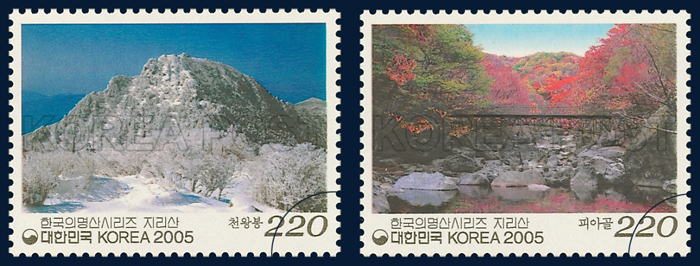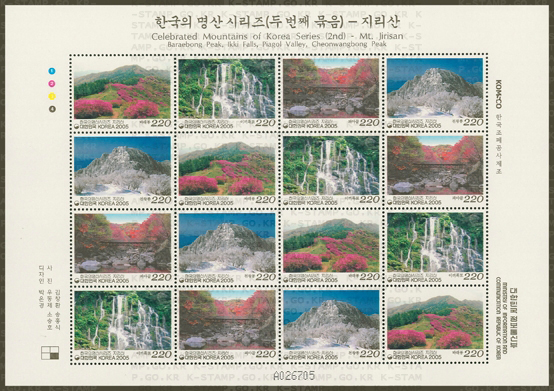-
 Korea.net's 24-hour YouTube channel
Korea.net's 24-hour YouTube channel- NEWS FOCUS
- ABOUT KOREA
- EVENTS
- RESOURCES
- GOVERNMENT
- ABOUT US
People who climb to the top of Cheongwangbok Peak, the highest point on Jirisan Mountain, are overwhelmed by the amazing view of the endless sea of clouds. Toward the west of the mountain's rocky wall there is an inscription engraved on the rock, "Cheonju," meaning, "a pillar holding up the sky."
The sunrise seen from atop the peak is considered one of the ten most beautiful sights on Jirisan Mountain. The spectacular view of the rising sun through the sea of clouds is very impressive. The rocky summit is always surrounded by clouds, and there is even a saying that people need to perform good deeds for three generations to be able to see the sunrise. Underneath the summit, there is a spring stream called Cheonwangsaem which flows from between the rocks.

Piagol Valley stretches nearly 20 kilometers from Yeongoksa Temple, located near the upper banks of Yeongokcheon Stream. Clean, with plenty of water from halfway up Banyabong Peak, the second highest peak of Jirisan, the stream continues to flow via Piagol Valley and past Yeongoksa Temple to eventually join Seomjingang River.
The autumn foliage's five colors, as seen in mid-October, is also one of the ten most beautiful sights on Jirisan Mountain.
Also in the autumn, the foliage is said to take on the colors of the mountains, the water and the people, and it is called, "an attraction of three reds."

By Limb Jae-un
Korea.net Staff Writer
Photos courtesy of Korea Post
jun2@korea.kr
The sunrise seen from atop the peak is considered one of the ten most beautiful sights on Jirisan Mountain. The spectacular view of the rising sun through the sea of clouds is very impressive. The rocky summit is always surrounded by clouds, and there is even a saying that people need to perform good deeds for three generations to be able to see the sunrise. Underneath the summit, there is a spring stream called Cheonwangsaem which flows from between the rocks.

Korea Post's 2005 stamp shows Piagol Valley (left) and Cheonwangbong Peak.
Piagol Valley stretches nearly 20 kilometers from Yeongoksa Temple, located near the upper banks of Yeongokcheon Stream. Clean, with plenty of water from halfway up Banyabong Peak, the second highest peak of Jirisan, the stream continues to flow via Piagol Valley and past Yeongoksa Temple to eventually join Seomjingang River.
The autumn foliage's five colors, as seen in mid-October, is also one of the ten most beautiful sights on Jirisan Mountain.
Also in the autumn, the foliage is said to take on the colors of the mountains, the water and the people, and it is called, "an attraction of three reds."

The second stamp set in the 'Celebrated Mountains of Korea' series shows many of Jirisan Mountain's scenic spots.
By Limb Jae-un
Korea.net Staff Writer
Photos courtesy of Korea Post
jun2@korea.kr
Most popular
- First hearing-impaired K-pop act hopes for 'barrier-free world'
- Event 'K-Beauty Hang Out' draws hundreds in Philippines
- Ceremony in Seoul inducts 2,641 content creators of Korean culture
- 'Mad Max' director impressed by 'cinema-literate' Korean viewers
- Cultural spring festival Seoul Festa to start on May 1













